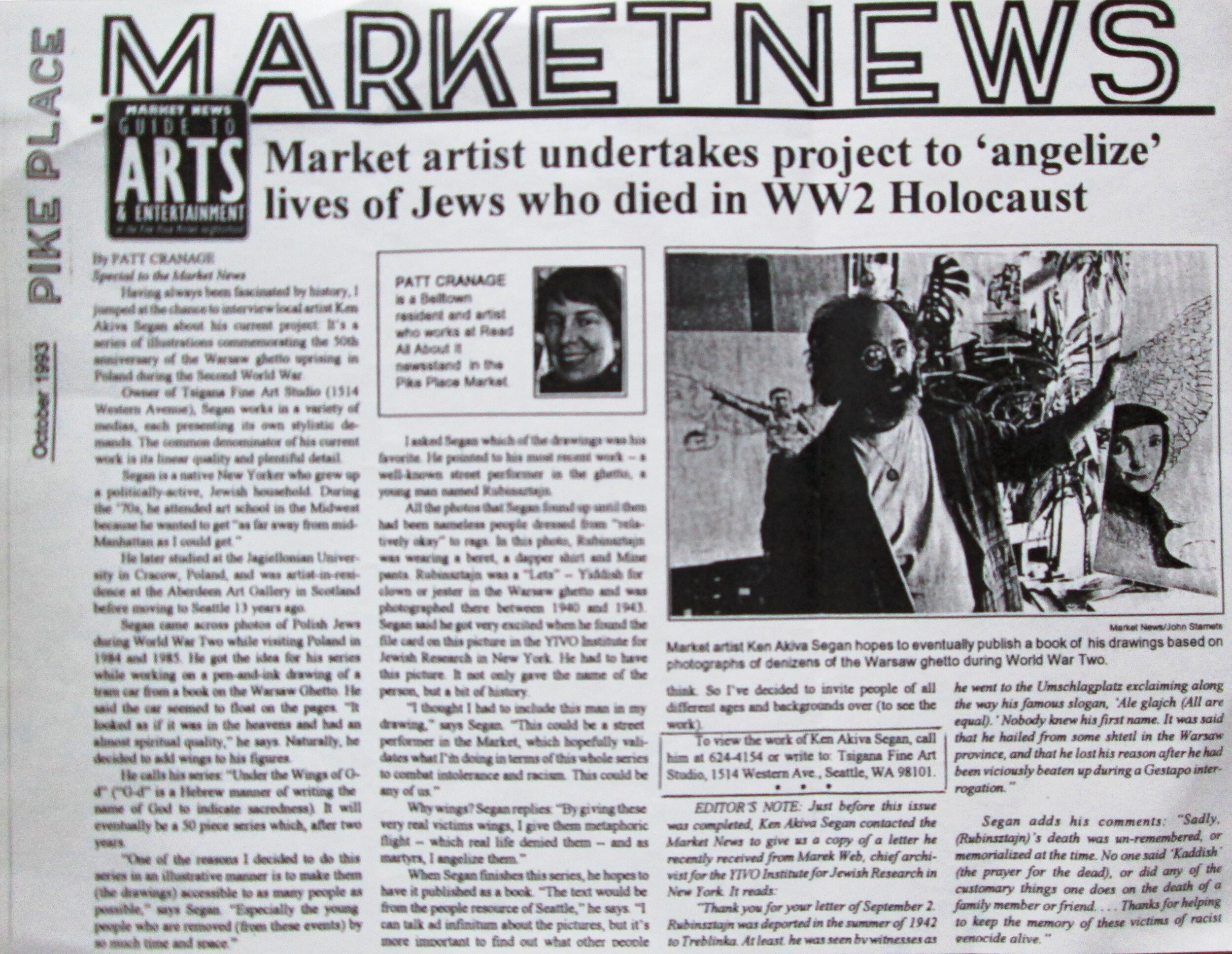Pike Place Market News
Market News Guide to Arts & Entertainment
in the Pike Place Neighborhood
October 1993
Market artist undertakes project to 'angelize' lives of Jews who died in WW2 Holocaust
By PATT CRANAGE
Special to the Market News
__________________________________________________
PATT CRANAGE is a Belltown resident and artist who works
at Read All About It newsstand in the Pike Place Market.
__________________________________________________
Photo: Market News /John Stamets.
Caption: Market artist Ken Akiva Segan hopes to eventually publish a book of his drawings based on photographs of denizens of the Warsaw ghetto during World War Two.
(The photo is of Segan holding UTW 14: Child with soup-plate in the Warsaw ghetto.
On the easel behind Segan: UTW 20: Rubinsztajn, mime in the Warsaw ghetto
___________________________________
Having always been fascinated by history, I jumped at the chance to interview local artist Ken Akiva Sgan about his current project: It's a series of illustrations commemorating the 50th anniversary of the Warsaw ghetto uprising in Poland during the Second World War.
Owner of Tsigana Fine Art Studio (1514 Western Aveue), Segan works in a variety of medias, each presenting its own stylistic demands. The common denominator of his current work is its linear quality and plentiful detail.
Segan is a native New Yorker who grew up in a politically-active, Jewish household. During the '70s he attended art school in the Midwest because he wanted to get "as far away from mid-Manhattan as I could get."
He later studied at the Jagiellonian University in Cracow, Poland, and was artist-in-residence at the Aberdeen Art Gallery in Scotland before moving to Seattle 13 years ago.*
Segan came across photos of Polish Jews during World War Two while visiting Poland in 1984 and 1985. He got the idea for his series while working on a pen-and-ink drawing of a tram car from a book on the Warsaw Ghetto. He said the car seemed to float on the pages. "It looked as if it was in the heavens and had an almost spiritual quality,' he says. Naturally, he decided to add wings to his figures.
He calls his series "Under the Wings of G-d" ("G-d" is a Hebrew manner of writing the name of God to indicate sacredness). It will eventually be a 50 piece series.
"One of the reasons I decided to do this series in an illustrative manner is to make them (the drawings) as accessible to as many people as possible," says Segan. "Especially the young people who are removed (from these events) by so much time and space."
I asked Segan which of his drawings was his favorite. He pointed to his most recent work - a well-known street performer in the ghetto, a young man named Rubinsztajn.
All the photos that Segan found up until then had been nameless people dressed from "relatively okay" to rags. In this photo, Rubinsztajn was wearing a beret, a dapper shirt and mine pants. Rubinsztajn was a "Lets" - Yiddish for clown or jester in the Warsaw ghetto. and was photographed there between 1940 and 1943. Segan said he got very excited when he found the file card for this picture in the YIVO Institute for Jewish Research in New York. He had to have this picture. It not only gave the name of the person, but a bit of history.
"I thought I had to include this man in my drawing," says Segan. "This could be a street performer in the Market, which hopefully validates what I'm doing in terms of this whole series to combat intolerance and racism. This could be any of us."
Why wings? Segan replies: " By giving these very real victims wings, I give them metaphoric flight - which real life denied them - and as martyrs, I angelize them."
When Segan finishes this series, he hopes to have it published in a book. "The text would be from the people resource of Seattle," he says. "I can talk ad infinitum about the pictures, but it's more important to find out what other people think. So I've decided to invite people of all ages and backgrounds over (to see the work).
EDITORS NOTE: Just before this issue was completed, Segan contacted the Market News to give us a copy of a letter he recently received from Marek Web, chief archivist for the YIVO Institute for Jewish Research in New York. It reads:
"Thank you for your letter of September 2. Rubinsztajn was deported in the summer of 1942 to Treblinka. At least he was seen by witnesses as he went to the Umschlagplatz exclaiming along the way his famous slogan," Ale glajch (All are equal).' No one knew his first name. It was said that he hailed from some Jewish shtetl in the Warsaw province, and that he lost his reason after he had been visciously beaten during a Gestapo interrogation."
Segan adds his comments: "Sadly, (Rubinsztajn's) death was un-remembered, or memorialized at the time. No one said 'Kaddish' (the prayer for the dead), or did any of the customary things one does on the death of a family member or friend. ...Thanks for helping keep alive the memory of these victims of racist genocide alive."

